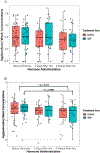Vaginal microbiome, antiretroviral concentrations, and HIV genital shedding in the setting of hormonal contraception initiation in Malawi
- PMID: 37877275
- PMCID: PMC10605758
- DOI: 10.1097/QAD.0000000000003686
Vaginal microbiome, antiretroviral concentrations, and HIV genital shedding in the setting of hormonal contraception initiation in Malawi
Abstract
Objective: The aim of this study was to understand how vaginal microbiota composition affects antiretroviral concentrations in the setting of hormonal contraception initiation.
Methods: Cervicovaginal fluid (CVF) concentrations of tenofovir, lamivudine, and efavirenz from 73 Malawian women with HIV were compared before and after initiation of depot-medroxyprogesterone acetate (DMPA) or levonorgestrel implant. We evaluated antiretroviral concentrations and vaginal microbiota composition/structure in the context of contraception initiation and predicted genital shedding using multivariable repeated measurements models fit by generalized estimating equations.
Results: Mean lamivudine CVF concentrations decreased 37% 1 month after contraception initiation. Subgroup analyses revealed a 41% decrease in women 1 month after initiating levonorgestrel implant, but no significant difference was observed in DMPA group alone. Tenofovir, lamivudine, and efavirenz CVF concentrations were positively correlated with anaerobic bacteria associated with nonoptimal vaginal microbiota. Risk of genital HIV shedding was not significantly associated with tenofovir or lamivudine CVF concentrations [tenofovir relative risk (RR): 0.098, P = 0.75; lamivudine RR: 0.142, P = 0.54]. Lack of association between genital HIV shedding and efavirenz CVF concentrations did not change when adjusting for vaginal microbiota composition and lamivudine/tenofovir CVF concentrations (RR: 1.33, P = 0.531).
Conclusion: No effect of hormone initiation on genital shedding provides confidence that women with HIV on either DMPA or levonorgestrel implant contraception will not have compromised ART efficacy. The unexpected positive correlation between antiretroviral CVF concentrations and certain bacterial taxa relative abundance requires further work to understand the mechanism and clinical relevance.
Copyright © 2023 Wolters Kluwer Health, Inc. All rights reserved.
Figures


References
-
- UNAIDS. Epidemiological Estimates, 2021. ; 2021. https://www.unaids.org/en/resources/documents/2021/global-commitments-lo...
-
- Polis CB, Phillips SJ, Curtis KM. Hormonal contraceptive use and female-to-male HIV transmission: a systematic review of the epidemiologic evidence. AIDS 2013; 27:493–505. - PubMed
-
- Phillips SJ, Polis CB, Curtis KM. The safety of hormonal contraceptives for women living with HIV and their sexual partners. Contraception 2016; 93:11–16. - PubMed
Publication types
MeSH terms
Substances
Grants and funding
LinkOut - more resources
Full Text Sources
Medical

